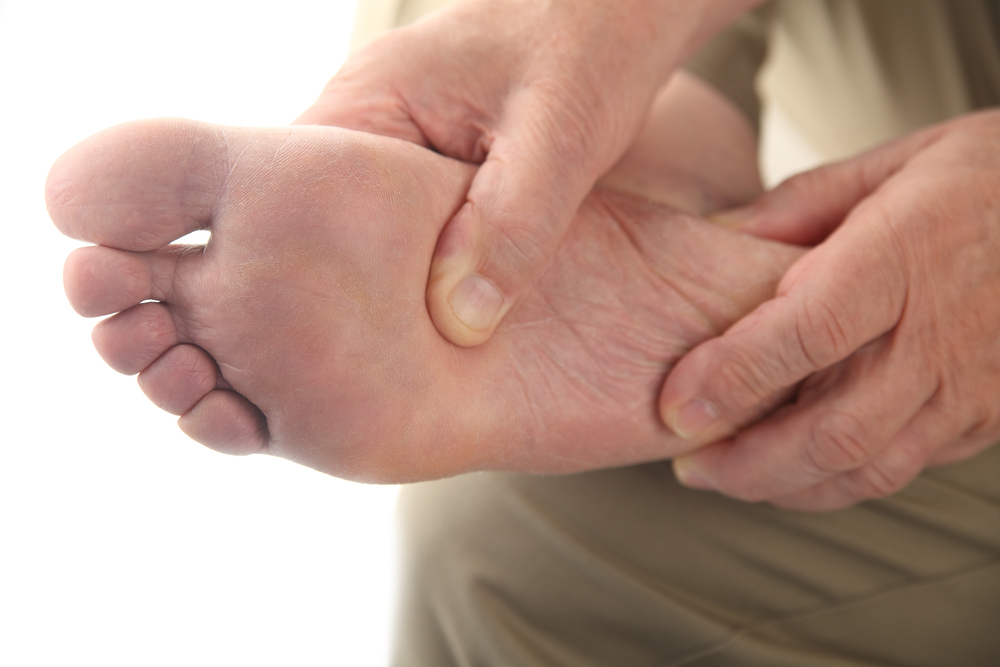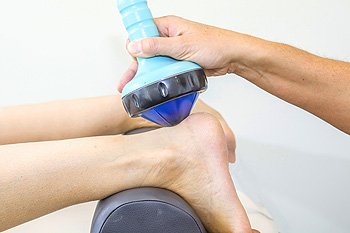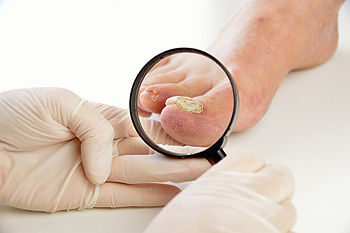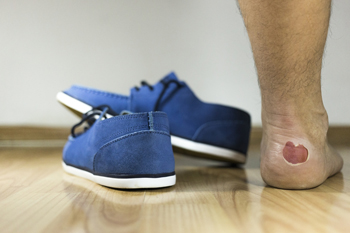January 2020
Can Sitting Lead To Poor Circulation?
 Poor circulation may occur in people who have medical conditions that include diabetes, or practice a sedentary lifestyle. Some of the symptoms that are associated with this condition may include a numbing or tingling sensation in the feet, and the feet may feel cold and tired. It may become worse with time, in which case there are measures that can be implemented which may help with poor circulation. These may include walking, swimming, and performing gentle stretching exercises. Additionally, eating foods that are healthy may increase circulation. If you are afflicted with poor circulation, it is suggested that you consult with a podiatrist who can help you to choose shoes that may prevent pain, in addition to protecting your feet.
Poor circulation may occur in people who have medical conditions that include diabetes, or practice a sedentary lifestyle. Some of the symptoms that are associated with this condition may include a numbing or tingling sensation in the feet, and the feet may feel cold and tired. It may become worse with time, in which case there are measures that can be implemented which may help with poor circulation. These may include walking, swimming, and performing gentle stretching exercises. Additionally, eating foods that are healthy may increase circulation. If you are afflicted with poor circulation, it is suggested that you consult with a podiatrist who can help you to choose shoes that may prevent pain, in addition to protecting your feet.
While poor circulation itself isn’t a condition; it is a symptom of another underlying health condition you may have. If you have any concerns with poor circulation in your feet contact Genine Befumo, DPM of University Foot and Ankle Center, L.L.C. Our doctor will treat your foot and ankle needs.
Poor Circulation in the Feet
Peripheral artery disease (PAD) can potentially lead to poor circulation in the lower extremities. PAD is a condition that causes the blood vessels and arteries to narrow. In a linked condition called atherosclerosis, the arteries stiffen up due to a buildup of plaque in the arteries and blood vessels. These two conditions can cause a decrease in the amount of blood that flows to your extremities, therefore resulting in pain.
Symptoms
Some of the most common symptoms of poor circulation are:
- Numbness
- Tingling
- Throbbing or stinging pain in limbs
- Pain
- Muscle Cramps
Treatment for poor circulation often depends on the underlying condition that causes it. Methods for treatment may include insulin for diabetes, special exercise programs, surgery for varicose veins, or compression socks for swollen legs.
As always, see a podiatrist as he or she will assist in finding a regimen that suits you. A podiatrist can also prescribe you any needed medication.
If you have any questions, please feel free to contact our office located in Monroe Township, NJ . We offer the newest diagnostic and treatment technologies for all your foot care needs.
What Conditions Does Shockwave Therapy Treat?
 Patients who experience chronic tendon pain may be interested in having shockwave therapy performed. This may be helpful in treating foot conditions that can include tendonitis and plantar fasciitis. There are two types of this kind of treatment. High energy treatments are completed in one session, and can be quite painful. Patients may choose to have some type of anesthesia administered when this type of treatment is performed. Low energy treatments are given in a series of three visits, and typically cause minimal discomfort. Shockwave therapy may accelerate the healing process, and this may be beneficial in alleviating symptoms. If you are interested in learning more about shockwave therapy and how it can help existing foot conditions, please consult with a podiatrist.
Patients who experience chronic tendon pain may be interested in having shockwave therapy performed. This may be helpful in treating foot conditions that can include tendonitis and plantar fasciitis. There are two types of this kind of treatment. High energy treatments are completed in one session, and can be quite painful. Patients may choose to have some type of anesthesia administered when this type of treatment is performed. Low energy treatments are given in a series of three visits, and typically cause minimal discomfort. Shockwave therapy may accelerate the healing process, and this may be beneficial in alleviating symptoms. If you are interested in learning more about shockwave therapy and how it can help existing foot conditions, please consult with a podiatrist.
Shockwave therapy is a treatment commonly used to treat various injuries and conditions, particularly plantar fasciitis in the feet. To learn more, consult with Genine Befumo, DPM from University Foot and Ankle Center, L.L.C. Our doctor can provide the care you need to keep you pain-free and on your feet.
Shockwave Therapy
Shockwave therapy is a new treatment option designed to treat bone conditions such as tennis elbow, shoulder pain, and others. Shockwave therapy uses high intensity sound waves that are directed to the affected tissues of the body with pinpoint accuracy. The effects are very beneficial, leading to a production of collagen fibers, eliminating inflammation.
Who Benefits from Shockwave?
Shockwave is recommended for patients suffering from heel pain and associated problems. Heel pain is a common condition which can be caused by obesity, overexertion, and spending a substantial amount of time on hard floors with your feet exposed and unsupported.
Fast and Easy
The therapy is actually a simple process that can leave patients feeling better the very next day. Shockwave therapy is not as dramatic as it sounds. It enables more blood flow to effected areas, addressing the source of the problem and allowing treatment to last for a long time.
Treatment & Recovery Time
Shockwave treatment will enable your feet to recover quickly. This is especially important since surgery is not required. It is cost effective and does not require the use of anesthesia. This treatment is a better option to surgery, since it is proven safe.
If you have any questions, please feel free to contact our office located in Monroe Township, NJ . We offer the newest diagnostic and treatment technologies for all your foot and ankle needs.
An Additional Toenail Fungus Treatment
 The medical condition referred to as onychomycosis is commonly known as toenail fungus. It can cause the nail to become thick and discolored. The traditional treatment of this ailment can consist of using topical creams, despite the fact they may be ineffective. Research has shown there may be another type of remedy for toenail fungus, referred to as laser treatment. This is performed by directing an adequate amount of light energy to the affected site, which can possibly destroy the damaged tissue. If you would like additional information about how laser treatment can be applied to toenail fungus, it is suggested that you schedule a consultation with a podiatrist.
The medical condition referred to as onychomycosis is commonly known as toenail fungus. It can cause the nail to become thick and discolored. The traditional treatment of this ailment can consist of using topical creams, despite the fact they may be ineffective. Research has shown there may be another type of remedy for toenail fungus, referred to as laser treatment. This is performed by directing an adequate amount of light energy to the affected site, which can possibly destroy the damaged tissue. If you would like additional information about how laser treatment can be applied to toenail fungus, it is suggested that you schedule a consultation with a podiatrist.
Laser treatment can be an effective way to get rid of toenail fungus. If you have any questions about laser treatment, consult with Genine Befumo, DPM from University Foot and Ankle Center, L.L.C. Our doctor will assess your condition and provide you with quality treatment for fungal nails.
What Are Toenail Fungal Infections?
Onychomycosis, or fungal infection of the nail, is a relatively common and non-serious condition. Around 10 percent of U.S. citizens are afflicted with fungal nails. Common forms of fungus that infect the nail include dermatophytes, yeasts, and molds.
Symptoms of Toenail Fungal Infections Include:
- Nail thickening
- Brittleness of the nail
- Discoloration of the nail
Diagnosis for Fungal Nails
Fungal infections are diagnosed by fungal culture and microscopy. This will rule out any other conditions such as nail trauma, psoriasis, lichen planus, and onychogryphosis.
What Is Laser Treatment?
Laser treatment is a non-invasive, safe, quick, and painless procedure that uses the heat from a laser to kill fungus in the nail. Each infected nail is targeted with a laser for several minutes. The treatment is usually utilized several different times over a select period. During this time, a podiatrist will keep an eye on the infection.
If you have any questions, please feel free to contact our office located in Monroe Township, NJ . We offer the newest diagnostic and treatment technologies for all your foot care needs.
Read more about Laser Treatment for Fungal NailsPossible Causes of Blisters
 An uncomfortable condition on your feet as a result of excessive friction may be referred to as a blister. It appears as a small area that is filled with fluid, which forms as the body’s natural defense to protect the damaged skin. Blisters on the feet are generally caused by wearing shoes that do not fit correctly, or from having excessively sweaty feet. It may be beneficial to protect the blister as daily activities are accomplished. This can be achieved by putting a bandage over the affected area, until it drains on its own when new skin has formed. If you get frequent blisters and would like advice on how to prevent them, please consult with a podiatrist.
An uncomfortable condition on your feet as a result of excessive friction may be referred to as a blister. It appears as a small area that is filled with fluid, which forms as the body’s natural defense to protect the damaged skin. Blisters on the feet are generally caused by wearing shoes that do not fit correctly, or from having excessively sweaty feet. It may be beneficial to protect the blister as daily activities are accomplished. This can be achieved by putting a bandage over the affected area, until it drains on its own when new skin has formed. If you get frequent blisters and would like advice on how to prevent them, please consult with a podiatrist.
Blisters are prone to making everyday activities extremely uncomfortable. If your feet are hurting, contact Genine Befumo, DPM of University Foot and Ankle Center, L.L.C. Our doctor can provide the care you need to keep you pain-free and on your feet.
Foot Blisters
Foot blisters develop as a result of constantly wearing tight or ill-fitting footwear. This happens due to the constant rubbing from the shoe, which can often lead to pain.
What Are Foot Blisters?
A foot blister is a small fluid-filled pocket that forms on the upper-most layer of the skin. Blisters are filled with clear fluid and can lead to blood drainage or pus if the area becomes infected.
How Do Blisters Form?
Blisters on the feet are often the result of constant friction of skin and material, usually by shoe rubbing. Walking in sandals, boots, or shoes that don’t fit properly for long periods of time can result in a blister. Having consistent foot moisture and humidity can easily lead to blister formation.
Prevention & Treatment
It is important to properly care for the affected area in order to prevent infection and ease the pain. Do not lance the blister and use a Band-Aid to provide pain relief. Also, be sure to keep your feet dry and wear proper fitting shoes. If you see blood or pus in a blister, seek assistance from a podiatrist.
If you have any questions, please feel free to contact our office located in Monroe Township, NJ . We offer the newest diagnostic and treatment technologies for all your foot care needs.
Wounds That Don't Heal Need to Be Checked
Blog Archives
- April 2024
- March 2024
- February 2024
- January 2024
- December 2023
- November 2023
- October 2023
- September 2023
- August 2023
- July 2023
- June 2023
- May 2023
- April 2023
- March 2023
- February 2023
- January 2023
- December 2022
- November 2022
- October 2022
- September 2022
- August 2022
- July 2022
- June 2022
- May 2022
- April 2022
- March 2022
- February 2022
- January 2022
- December 2021
- November 2021
- October 2021
- September 2021
- August 2021
- July 2021
- June 2021
- May 2021
- April 2021
- March 2021
- February 2021
- January 2021
- December 2020
- November 2020
- October 2020
- September 2020
- August 2020
- July 2020
- June 2020
- May 2020
- April 2020
- March 2020
- February 2020
- January 2020
- December 2019
- November 2019
- October 2019
- September 2019
- August 2019
- July 2019
- June 2019
- May 2019
- April 2019
- March 2019
- February 2019
- January 2019
- December 2018
- November 2018
- October 2018
- September 2018
- August 2018
- July 2018
- June 2018
- May 2018
- April 2018
- March 2018
- February 2018
- January 2018
- December 2017
- November 2017
- October 2017
- September 2017
- August 2017
- July 2017
- June 2017
- May 2017
- April 2017
- March 2017
- February 2017
- January 2017
- December 2016
- November 2016
- October 2016
- September 2016
- August 2016
- July 2016
- June 2016
- May 2016
- April 2016
- March 2016
- February 2016
- January 2016
- December 2015
- November 2015
- October 2015
- September 2015
- August 2015
- July 2015
- June 2015
- May 2015
- April 2015
- March 2015
- February 2015
- January 2015
- December 2014
- November 2014
- October 2014
- September 2014
- August 2014
- July 2014





